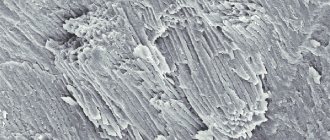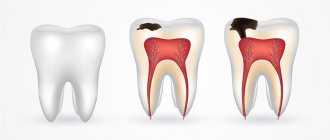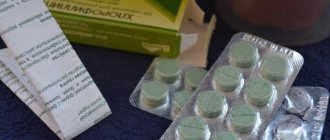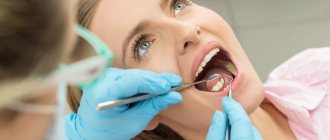What it is?
The essence of the procedure is preliminary cleaning of the oral cavity with alternate treatment with the first and second composition
The progressive demineralization of tooth enamel from the aggressive action of acids and the development of caries can be protected by using deep fluoridation.
To carry out the procedure, it is recommended to use enamel sealing liquid, which contains a strong mineral complex and has an effective restorative effect.
When applying the product to the surface of the teeth, the active components of the first composition penetrate into the pores, filling the voids, and the substances of the second fix the achieved result by sealing.
The essence of the procedure is preliminary cleaning of the oral cavity (teeth and mucosal surface) with alternate treatment with the first and second composition.
Fluoride, when combined with highly dispersed calcium hydroxide, provides deep fluoridation of the enamel structure, that is, it makes the tissue of the tooth neck hard. The session ends with mouth rinsing.
Benefits of deep fluoridation
The main advantages of deep fluoridation are:
- reduction in the incidence of caries by 65%;
- improving the structure of the enamel layer;
- significant reduction in tooth sensitivity;
- tenfold increase in the density of tooth enamel;
- reducing the risk of developing secondary caries;
- increasing the service life of previously placed fillings;
- quickly normalize the condition of the oral mucosa and gum tissue.
It has been proven that the effect of deep fluoridation lasts for 11 months after the end of the preventive course. However, this does not mean that this procedure provides complete protection of teeth from caries and other dental pathologies. Both deep and superficial fluoridation can only reduce the risk of developing diseases and increase the resistance of enamel to the action of destructive environmental factors. In order to ensure comprehensive dental protection, sufficient attention should be paid to all existing preventive measures.
Indications for use
The sealing composition is recommended for use for the following purposes:
- The deep fluoridation procedure is prescribed after removal of braces and a large accumulation of yellow plaque near the gums
to prevent the development of caries and treat lesions;
- when carrying out mineralization of fissures;
- for the prevention of other (non-carious) lesions of the enamel structure;
- to reduce the sensitivity of the neck of the tooth;
- after teeth whitening.
The deep fluoridation procedure is prescribed after the removal of braces, a large accumulation of yellow plaque near the gums, as well as pain that occurs when performing oral hygiene procedures.
Composition of the drug
The sealing liquid complex includes two liquids (usually 20 ml each):
- for primary processing;
- for the final one.
The preparation for primary treatment contains: anhydrous magnesium fluoride silicate, anhydrous copper fluoride silicate-||, sodium fluoride (functions as a stabilizing component), distilled water.
The composition of the second solution includes: highly dispersed calcium hydroxide, methylcellulose, distilled water.
The operating principle of the product is based on the properties of the active components:
- the ability to inhibit the process of enamel demineralization;
- remineralization of defects with high concentrations of fluoride ions;
- bactericidal effect due to the content of copper ions;
- attachment of hydroxyapatite microcrystals to collagen with the participation of copper ions, which ensures “self-assembly” of the tissue;
- increasing the resistance of teeth to carious influences, which is achieved thanks to magnesium ions.
Treatment of hypersensitivity of teeth with the drug “Dentin-sealing liquid”
Increased tooth sensitivity brings a lot of discomfort. The lesion may affect one or all teeth at once. The enamel becomes sensitive to hot and cold water, sour, sweet. Even just cool air when inhaling can cause pain. The dentists of our clinic will help you carry out high-quality diagnostics and prescribe effective treatment, regardless of the cause of this problem.
Treatment may include a whole range of measures, such as: adjustments to oral care, recommendations on how and with what to rinse teeth, treatment of the crowns of teeth with a special gel, advice on using a certain toothpaste, etc. For deeper carious lesions or cracks, it may be necessary to treat the tooth at the site of enamel damage with a filling.
In many cases, the drug “Dentin-sealing liquid” shows an excellent effect. It helps restore hard tooth tissues and prevents the development of caries. Recommended as a cushioning material when installing ceramic and other types of fillings. It has powerful antibacterial properties, as it contains copper ions. The bactericidal property makes it possible to maintain the sterility of dentin and enamel under restoration for a long time.
The drug has received many positive reviews from dentists around the world.
The sealing liquid consists of two bottles with different compositions. They are used as follows:
- the surface or cavity of the cleaned tooth (stump) is degreased and dried;
- apply composition No. 1;
- excess product is removed with a swab and dried if necessary;
- apply composition No. 2 (shake thoroughly before application);
- Next, a filling is applied.
Composition No. 2 contains a lot of calcium, which “seals” dentin, replacing damaged tooth enamel. Our clinic actively uses this drug in treatment. We will help you restore your teeth and restore the ability to eat sweet, sour, and cold foods without discomfort. Make an appointment with our specialists right now! Contacts are on the website.
Step-by-step instructions for use
A properly performed procedure ensures a high-quality result from the use of sealing enamel.
Deep fluoridation of teeth is performed in the following sequence according to the instructions:
- A properly performed procedure ensures a high-quality result from the use of sealing enamel
The dentist examines the oral cavity, determines the condition of the enamel and soft tissues.
- Plaque is removed from the surface with a toothbrush and special cleaning agents.
- The teeth are dried under the influence of warm air.
- Liquid No.1 is applied to a cotton pad. Next, the teeth are carefully processed.
- The next step is to wet the tooth surface with liquid No2 using a cotton swab. In this case, there is no need to carry out intermediate rinsing of the mouth.
- The procedure is completed by thoroughly rinsing the mouth.
At the end of the session, the patient is asked to sit in a chair with his mouth open for about 5-7 minutes. This is necessary for reliable fixation of the composition with the enamel.
Indications for the use of dentin-sealing liquid
- Elimination of dentin sensitivity;
- When arranging seal gaskets;
- To prevent the recurrence of caries;
- For complete protection of dentin and pulp;
- To stimulate dentin formation.
Dentinal canals are sealed using sequential treatment with the first and second compositions. The use of such processing technologies makes it possible to abandon the use of other linings in the filling process, regardless of the type of filling materials used, while ensuring a high level of pulp protection.
The strengths of using a dentin-sealing composition for deep fluoridation of teeth is its ability to reliably block acids and other aggressive components released from cements and negatively affecting the pulp. In addition, the composition retains its own bactericidal capabilities for a long time.
Sequencing
- The oral cavity is degreased and dried;
- Treatment is carried out with composition No. 1 using a cotton swab;
- Without rinsing, a similar treatment with composition No. 2 is carried out;
- Next, the treated surfaces are dried with warm air.
If the cavities are located as close as possible to the pulp, while having significant depth, it is recommended to perform the procedure in the reverse order, first treating with composition No. 2, and then with composition No. 1.
After treating your teeth with composition No. 2, after a few minutes you can rinse your mouth, drink and eat.
Application
For the prevention of caries through deep fluoridation (mineral sealing of enamel)
Before the procedure, the teeth should be cleaned with a toothbrush, the spaces between the molars and incisors should be carefully worked with a special thread.
Before the procedure, your teeth should be cleaned with a toothbrush, and the spaces between the molars and incisors should be carefully worked with a special thread.
Next, drying is performed using a warm air stream, after which the teeth are treated with a swab moistened in liquid No. 1 for 5 minutes.
Without rinsing your mouth, treat the surface with liquid No2 in the same way. After a couple of minutes, the patient is asked to rinse his mouth.
Deep fluoridation for the purpose of caries prevention is carried out 1-2 times a year. The mechanism of action of the active components is to fill pores and microcracks with subsequent tissue remineralization.
In the course of the studies, the majority of patients showed positive results in the restoration of tooth enamel.
For mineral sealing of fissures
The procedure is carried out in the same way as for the prevention of caries on fissures that have been previously cleaned of plaque. The active substance used for sealing is water-containing silica.
The mineral composition works extremely gently, without expanding the hard structure of the fissures or having minimal impact on them.
Due to the content of calcium fluoride in the composition, prolonged remineralization is ensured with the participation of saliva. Repeated treatment is carried out after 8-12 months.
Effect
After treating the teeth enamel with a sealing liquid, there is a decrease in hypersensitivity to temperature changes and sweets
After treating the enamel with a sealing liquid, the hardness and strength of the tooth enamel significantly increases, which reduces the risk of caries.
There is also a decrease in hypersensitivity to temperature changes and sweets. The achieved coating result lasts up to a year.
The achieved effect can be extended if you follow simple rules:
- reduce sugar consumption, it is recommended to replace refined sand with fructose;
- sweets that destroy tooth enamel should be replaced with fruits, dried fruits, and nuts;
- after each meal you need to brush your teeth with a special floss and rinse with balm;
- morning and evening, perform oral hygiene procedures using high-quality toothpaste and a properly selected brush.
Deep fluoridation
The technique of deep fluoridation of enamel is a complex of dental procedures, which are based on the professional treatment of teeth enamel - sealing liquids.
Stages of deep fluoridation
This procedure consists of the following steps:
- sanitation of the oral cavity, professional dental cleaning;
- drying the surface of the teeth with a directed flow of warm air;
- applying magnesium fluoride silicate with calcium and copper ions to the enamel;
- repeated drying of the tooth surface with warm air;
- application of highly dispersed calcium hydroxide to the enamel.
Proper implementation of the procedure allows for deep penetration of the enamel-sealing liquid into the affected tissues and creates a maximum concentration of fluoride ions in them. In this case, the natural mineral structure of the teeth does not undergo any changes.
Contraindications
The use of zmal sealing liquid for deep fluoridation is prohibited in the following cases:
- in the presence of viral and colds;
- allergies to one of the components included in the composition;
- if diabetes mellitus is diagnosed;
- when the level of fluoride in the body exceeds the norm.
Pregnancy is not a contraindication. The procedure is performed locally, without posing a threat to the fetus and the woman’s overall health.
Dentin enamel sealing liquid tiefenfluorid
The drug Tiefenfluorid is effective for sealing fissures - natural depressions on the teeth that perform the function of chewing food.
During the procedure, active substances fill the voids in the pores where the combination of calcium copper hydroxide and fluoride silicate complex occurs.
As a result, tiny crystals of calcium fluoride and silicic acid gel are formed.
When they penetrate into the pores of the loosening structure of the enamel, they contribute to the accumulation of fluoride ions, resulting in the formation of a high degree of saturation with a valuable microelement. This method exceeds the use of fluoride-containing pastes by five times.
This method is recommended for patients who are forced to wear orthopedic structures, as well as for children aged 10-12 years who have defects in the dental structures.
Enamel sealing liquid humanchemie
The drug is intended to prevent the development of caries and restore the enamel structure.
The product has high bactericidal activity, prevents the formation of microbial biofilm on the surface of the teeth, and protects the pulp and dentin from microorganisms.
The enrichment of the enamel structure with essential minerals is achieved through the inclusion of copper ions in the composition of the preparation.
Composition of preparation No. 1: anhydrous magnesium fluoride silicate, anhydrous copper fluoride silicate-||, sodium fluoride (as a stabilizer), distilled water. Composition of preparation No. 2: highly dispersed calcium hydroxide, methylcellulose, distilled water. Indications for use: for desensitization of the tooth neck by deep fluoridation of the hard substance, for optimal local caries prevention, for mineral sealing of fissures. After deep fluoridation, as a result of the remineralizing effect of fluoride, in many cases there is a restoration of defects that existed on the surface of the tooth, in particular the so-called chalk stain. Recently, data have been obtained suggesting that the remineralization of enamel with Tiefenfluoride with the formation of a regular structure of hydroxyapatite crystals on keratin fibers is largely due to the copper ions it contains. This phenomenon is called “self-assembly”. Thanks to it, the transparency of the enamel is restored. Enamel-sealing liquid (Deep Fluoride®), having powerful bactericidal activity, helps suppress the formation of microbial biofilm on the surface of the enamel, protects dentin and pulp in the event of microbe penetration through the deep pores of the enamel and tubules of exposed dentin. Tifenfluoride contains magnesium ions in fairly high concentrations. Mechanisms of action of Enamel - a sealing liquid (Deep fluoride®) for dental hyperesthesia The main mechanism underlying the therapeutic effect of Tifenfluoride for dental hypersensitivity is to ensure remineralization of enamel. This results in the filling of the spaces between the keratin fibers formed by the action of acids, first with silicic acid gel and then with hydroxyapatite. The conductivity of these mineral substances is significantly less than the conductivity of the liquid filling the pores of loose demineralized enamel. As a result, there is a rapid and pronounced relief (more often, complete disappearance) of hypersensitivity phenomena, most pronounced in the cervical region due to the structural features of the enamel A. Knappvost , University Professor, Doctor of Physical, Chemical and Medical Sciences, Institute of Physical Chemistry with the Department of Biophysical Chemistry and Scientific Research in dentistry", Hamburg, Germany Enamel-sealing liquid (Deep fluoride®). Mechanisms of caries-preventive action. Numerous clinical observations suggest that deep fluoridation is an effective method for the prevention of caries and demineralization of enamel with acids. To implement this, we use an enamel-sealing liquid (tifenfluoride) developed by us. This is a kit consisting of two liquids. Liquid No. 1 is magnesium fluoride silicate with copper and calcium ions. Liquid No. 2 is a suspension of highly dispersed calcium hydroxide. The tooth surface is thoroughly moistened first with the first solution, and after 0.5-1 minutes with the second. As a result of the interaction of these drugs, CaF2, MgF2, CuOF crystals with a size of ~50 A (5 nm) are formed inside the enamel pores and/or in the dentin tubules in a silicic acid gel, which prevents the leaching of microcrystals (24). This substance is found in the pores of the enamel for 0.5-1 year after treatment. Fluoride microcrystals create a high fluoride concentration of ~100 mg/l (~2x10-4 Mol/l) in saliva adjacent to the enamel surface. Thanks to fluoride ions, demineralization is prevented by increasing the level of acids of microbial origin, which prevents the occurrence of caries (Table 2). Mechanisms of caries-preventive action of Enamel-sealing liquid (Deep fluoride®) (tifenfluoride)
- Prevention of enamel demineralization and remineralization of defects with high concentrations of fluoride ions
- Bactericidal effect of copper ions
- Participation of CuII copper ions in the attachment of hydroxyapatite microcrystals to collagen (“self-assembly”)
- Action of magnesium ions (hypothesis)
After deep fluoridation, as a result of the remineralizing effect of fluoride, in many cases there is a restoration of defects that existed on the surface of the tooth, in particular the so-called chalk stain. Recently, data have been obtained suggesting that the remineralization of enamel with Tiefenfluoride with the formation of a regular structure of hydroxyapatite crystals on keratin fibers is largely due to the copper ions it contains. This phenomenon is called “self-assembly”. Thanks to it, the transparency of the enamel is restored. The enamel-sealing liquid, having powerful bactericidal activity, helps suppress the formation of microbial biofilm on the surface of the enamel, protects dentin and pulp in the event of microbial penetration through the deep pores of the enamel and the tubules of exposed dentin. Tifenfluoride contains magnesium ions in fairly high concentrations. Recently, a hypothesis has been discussed according to which magnesium ions contribute to increasing the resistance of teeth to carious influences. In our studies conducted on human teeth, the highest levels of magnesium were found in incisors, which are known to withstand particularly high loads. Mechanisms of action of Enamel-sealing liquid (Deep Fluoride®) for dental hyperesthesia The main mechanism underlying the therapeutic effect of Tifenfluoride for dental hypersensitivity is to ensure remineralization of enamel. This results in the filling of the spaces between the keratin fibers formed by the action of acids, first with silicic acid gel and then with hydroxyapatite. The conductivity of these mineral substances is significantly less than the conductivity of the liquid filling the pores of loose demineralized enamel. As a result, there is a rapid and pronounced relief (more often, complete disappearance) of hypersensitivity phenomena, most pronounced in the cervical region due to the structural features of the enamel (Table 3). Effect of Enamel-Sealing Liquid (Deep Fluoride®) on Dental Hypersensitivity
- Physiological remineralization of enamel
- Hermetic sealing of dentinal tubules with a non-toxic mineral substance
When applying Enamel-sealing liquid (as well as Dentin-sealing liquid) to areas with open dentinal tubules, as a result of the interaction of liquids No. 1 and No. 2, a mineral “plug” is formed inside the dentinal tubules. Its thickness is relatively small, but it is quite sufficient for reliable and hermetically sealing the entrance to the tubules. Unlike Enamel-Sealing Liquid, other currently known desensitizing drugs intended for the treatment of dental hyperesthesia, for example, double-action desensitizer (USA), do not lead to increased remineralization and physiological restoration of enamel. Their effect, quite short-lived, is the result of the formation of partitions in the dentinal tubules due to the denaturation of proteins in the dentinal fluid. Indications for the use of Enamel-sealing liquid and its clinical effectiveness Enamel-sealing liquid (Tifenfluoride) has undergone extensive clinical testing both in Germany and in other countries. The main indications for the use of Enamel-sealing liquid are presented in Table 4. Indications for the use of the deep fluoridation method (regulatory documents approved by the StAR Council on April 20, 2004)
- Prevention of caries, including fissure
- Treatment of initial caries (at the spot stage)
- Prevention of non-carious enamel lesions
- Treatment of the active stage of dental erosion
- Treatment of hypersensitivity (including after bleaching)
The effectiveness of Tifenfluoride has been extensively documented and praised in numerous publications. In particular, it was shown that annual 1-2-fold treatment with the drug led to the protection of teeth from fissure caries in 95% of cases. Complete relief of dental hypersensitivity was noted in more than 85-90% of patients, and for a long period (from 1 year or more). Fluoride released from filling materials does not protect teeth from secondary caries. As numerous studies and many years of clinical experience have shown, the permeability of restorations to bacteria has a decisive influence on the preservation time. In particular, marginal cracks formed as a result of polymerization shrinkage of filling materials lead to the emergence of ecological niches for the penetration and development of microbes and the occurrence of caries. Many materials cannot withstand the load during chewing, resulting in cracks in seemingly well-sealed cavities. In many publications, the role of a factor protecting against the occurrence of secondary and recurrent caries is attributed to fluoride released from restoration materials. However, we cannot agree with this position. A number of our works present theoretical and experimental substantiations according to which fluoride in restoration materials (GIC, composites) cannot provide caries prevention. Arguments explaining the inconsistency of ideas about the caries-preventive effect of fluoride-containing restoration materials include:
- Dentin caries under filling material is not a consequence of the dissolution of hydroxyapatite, since there is practically no solvent. Therefore, the remineralizing properties of fluoride, so important in the prevention of primary caries, are unclaimed in this situation.
- Dentin caries is caused mainly by the destruction of the organic component under the influence of microorganisms. Therefore, to prevent secondary and recurrent caries, it is necessary to ensure the sterility of the tooth cavity and dentin.
- The amount of fluoride released from filling materials is insufficient to achieve a pronounced bactericidal effect for the following reasons:
- The release of fluorine from polymers and GIC (usually in the form of simple fluorides, for example NaF) occurs within a short time and in limited quantities, because after curing, it is rigidly held by the matrix.
- Simple fluorides interact with hydroxyapatite to form coarse-crystalline CaF2, which can create a fluorine concentration in the cavity of about 10-12 mg/l, which is not enough to have a bactericidal effect.
Convincing evidence of the ineffectiveness of the caries-preventive effect of fluoride-containing restoration materials is the high level of secondary and recurrent caries observed in clinical practice. It should be noted that some manufacturers of restoration materials have removed from their descriptions references to the presence of fluoride, which supposedly has a caries-preventive effect. Finally, the problem of preventing secondary caries will confront doctors in a real light, which means we can hope that new opportunities will open up for the introduction of methods that truly protect teeth from the effects of microbial factors.
Price
The cost of the drug depends on the volume of bottles with working fluids and the manufacturer.
For example, Enamel-sealing liquid (20g+20g) from the HumanChemie brand can be purchased at a price of 4,298 rubles.
The cost of one deep fluoridation procedure in a dental center will cost approximately 3,000 – 3,400 rubles.
At the same time, it includes: cleaning the oral cavity, polishing the teeth using a special paste and brush, applying an enamel sealing liquid.
Surface fluoridation of teeth
Surface fluoridation of teeth is a set of simple and painless dental procedures that involve enriching dental tissues with fluoride using special gels or varnishes.
In the first case, an individual dental tray filled with sodium fluoride or another fluoride-containing drug is used for remineralization. The device is carefully placed on the patient’s teeth and held on them for about a quarter of an hour. To achieve the desired effect, the procedure is carried out 3 times in a row with an interval of 2 days.
Stages of surface fluoridation
In turn, fluoridation of teeth using fluoride varnish is carried out in several stages and involves:
- cleaning the enamel layer from deposits;
- drying the surface layer of teeth with warm air;
- applying fluoride-containing varnish to the enamel using a special brush or a ball of sterile cotton wool (the upper row of teeth is initially treated, and then the lower row);
- drying the varnish.
After completing the procedure, the patient is advised to stop eating solid foods and brushing his teeth for a day. To achieve a lasting result, the varnish is applied to the enamel surface several times with an interval of 2 days. A second course of fluoridation may be required no earlier than after 7 months.











